Wondering if your organization really needs an editorial calendar? Or, is it just another fancy tool in a content marketer’s stash?
Smart marketers know that consistently producing quality content is the key to driving traffic and converting leads, but it’s challenging to maintain a regular publishing cadence without a central hub for planning, tracking, and coordinating content activities.
An editorial calendar offers all this and then some more.
In fact, it makes all the difference between a successful content strategy and one that drags its way to the finish line (or perhaps doesn’t even make it there).
So let’s talk about how you can benefit from adding one to your toolbox and show exactly how to get yours set up in five simple steps.
Make Planning Easy With Your Editorial Calendar Template
Creating an editorial calendar from scratch can be pretty time-consuming. You’d rather spend that time planning and creating content.
To help you get ahead of the game, we created this editorial calendar template.
All you have to do is fill in the details like the shortlisted content pieces’ audience, target keywords, due dates, visual assets to create, and so on.
[content_upgrade_shortcode]
When you’re ready to upgrade further efficiency, consider an alternative like CoSchedule. We’ll be here whenever you decide it’s time.
Table of Contents
- So … What Exactly is an Editorial Calendar, Anyway?
- Okay, But Why Should I Use an Editorial Calendar?
- What Are My Options for Editorial Calendar Tools and Software?
- Let’s Look at an Example of an Editorial Calendar
- Now, Let’s Set Up Your Editorial Calendar Step by Step
- The Numbers Don’t Lie: Proof That Editorial Calendars Work
- Common Questions About Editorial Calendars
So … What Exactly is an Editorial Calendar, Anyway?
An editorial calendar is a planning document that gives you an overview of what’s in your publication pipeline.
It helps plan, manage, and coordinate the various stages involved in content creation – idea generation, production, publishing, and promotion.
Traditionally, they’ve been used to visualize blog posts and articles. But you can expand yours to manage any type of content you publish. Be it social, digital, print, video content – you name it.
But there’s more to it than this overview.
By giving a bird’s-eye view, an editorial calendar shows how strategically you’re creating content to appeal to your target audience in various stages of their buyer’s journey.
And, if you market to multiple target personas, you can also tell whether you’re creating sufficient content for each.
Besides a big picture view, it will also give you and your team a plan of action to follow for pumping out content consistently.
Hence, it’s part a strategic content planning tool and part a place to coordinate with your team for a consistent, on track content schedule.
To break it down, an editorial calendar should:
- Be an idea bank to offload post ideas and key topics.
- Enable team coordination on creating content.
- Provide a publishing strategy and schedule for consistency.
- Allow you to make in-process adjustments with drag-and-drop ease.
- Help visualize your content marketing strategy to make it comprehensible for everyone.

Okay, But Why Should I Use an Editorial Calendar?
Without a calendar, you’ll likely find yourself disorganized – unsure of what’s to be covered next, who’s working on what, and which deadlines are due.
You might also come face-to-face with an important holiday, event, or initiative; ending up rushing to coordinate content activities around it.
Between this lack of coordination and no view of what’s in the pipeline, creating content consistently can feel like juggling several plates at a time; only to crash a couple.
So let’s review the compelling reasons to use an editorial calendar:
1. Get Organized
An editorial calendar gives you a central hub for storing content ideas, visualizing your publishing schedule, and building out a workflow from the approved ones. With it, you can tell what’s due, in progress, within the editing stage, and so on – all at a glance.
2. Plan Content Strategically
Good content marketing is strategic. It involves creating content that solves your target persona’s problem and meets them where they are at in their buyer’s journey.
But while you can plan out articles to meet all these requirements, you can’t get a full picture of how each piece connects with another and its overall purpose until it’s laid out in a calendar interface.
With a calendar, you get an easily understandable look at:
- What content you’ll create.
- Who will create that content.
- When the content is due.
- Why you’re creating the content and for whom.
3. Provide Visibility Into What Content is Being Created
In addition to showing you what’s in production, an editorial calendar makes it simple for stakeholders to see the same.
Such a 10,000-foot view means you can also coordinate content campaigns and themes. Plus, you can tell how much content you’re publishing for each funnel stage.
4. Manage and Hit Deadlines
There’s nothing that makes coordination as easy as pre-planned due dates and a place to assign editorial tasks from. A content calendar provides both.
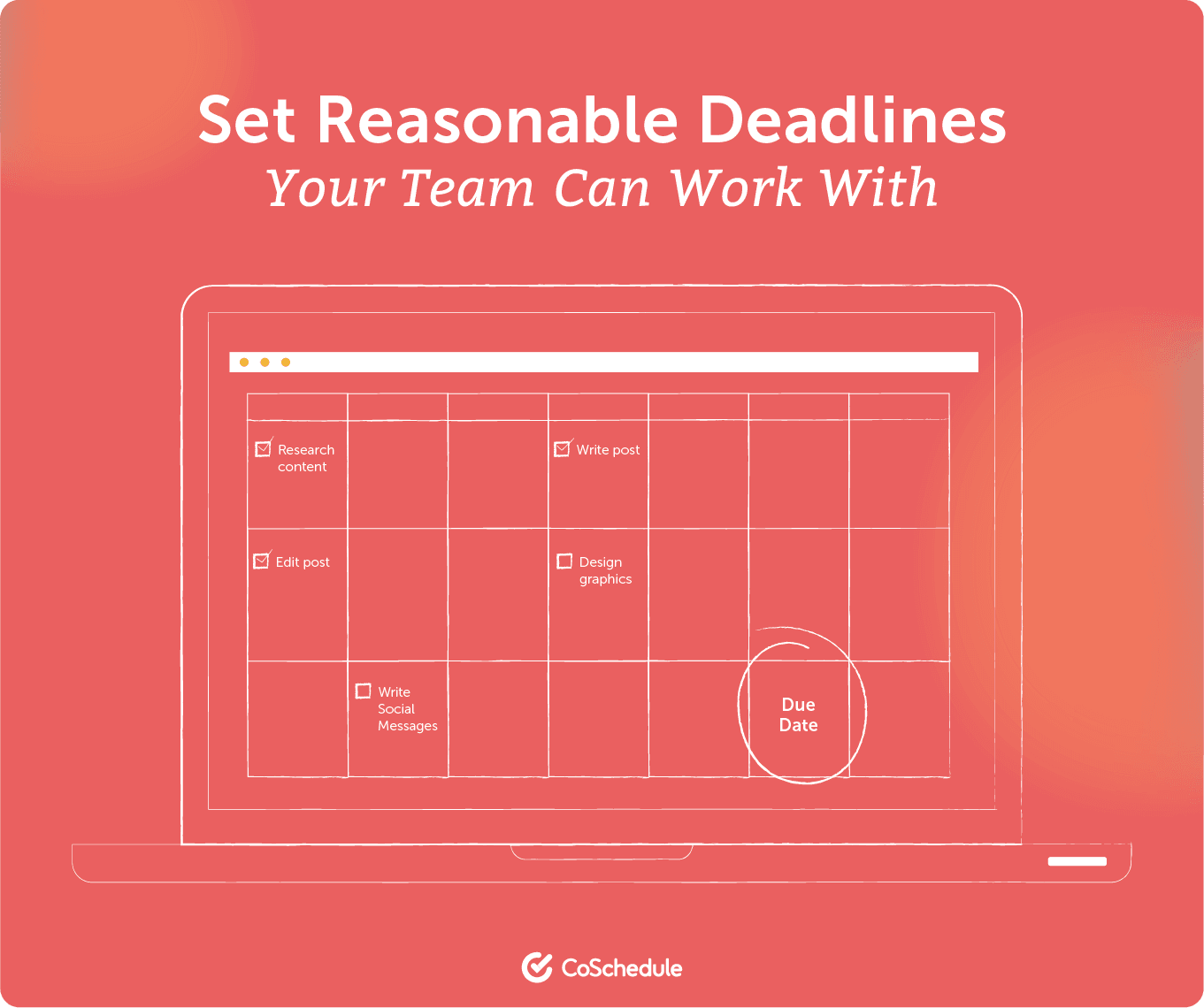
Key players involved in content creation get visibility of the tasks they’re responsible for and related deadlines. This way, you and your team are more likely to stay on track of the work due without coming close to last-minute requests.
Plus, the workflow that an editorial calendar offers helps build failsafes. This gives you plenty of time for everything be it keyword research or getting stakeholder approval since you can do all that weeks in advance.
5. Publish More and Better Content, More Easily
With a well-planned workflow, better deadline management, and fully fleshed-out content topics, you’ve everything you need to do to hit publish.
In fact, with everything planned to the tee, you can focus on the content quality. You’ll be creating each piece of content ahead of time – more on this in a bit – which means you’ve plenty of time to review and polish for quality.
What Are My Options for Editorial Calendar Tools and Software?
Convinced you need a content marketing editorial calendar? Great. Let’s look at available options:
Printed Calendars: Going Old-School
Printed calendars are great for those of you who need to get out of the digital setting for an outlook of your content workflow.
You can have an annual or four quarterly calendars paired with monthly calendars showing what’s going on.
These calendars come with major downsides though:
- They don’t support team coordination. There’s no way you can use the calendar to coordinate assigning editorial work.
- The calendar is uneditable. So you can’t move content pieces through their stages such as from ideation to in progress or mark them complete once done.
Spreadsheets: Free and Simple

A spreadsheet can help overcome the shortcomings of a print calendar. They are everything that printed calendars are except digital, and are therefore editable and useful for team collaboration.
Because they’re cost-effective and so much better than not having a calendar, these are great for those of you getting started with an editorial calendar.
But they aren’t free from drawbacks, which include:
- Disconnected workflows. The calendar is separate from your social channels and email platform so it’s no help with content promotion.
- Lack of automation. This means you can’t automate tasks like publishing with a spreadsheet.
- Communication isn’t hurdle-free. Team members have to leave comments in the sheet that are hard to keep track of, which sets the need for a separate communication tool.
Ultimately, spreadsheets are challenging to maintain and not a ton of fun to use.
CoSchedule: Powerful Visibility, Automation, and Workflow Management
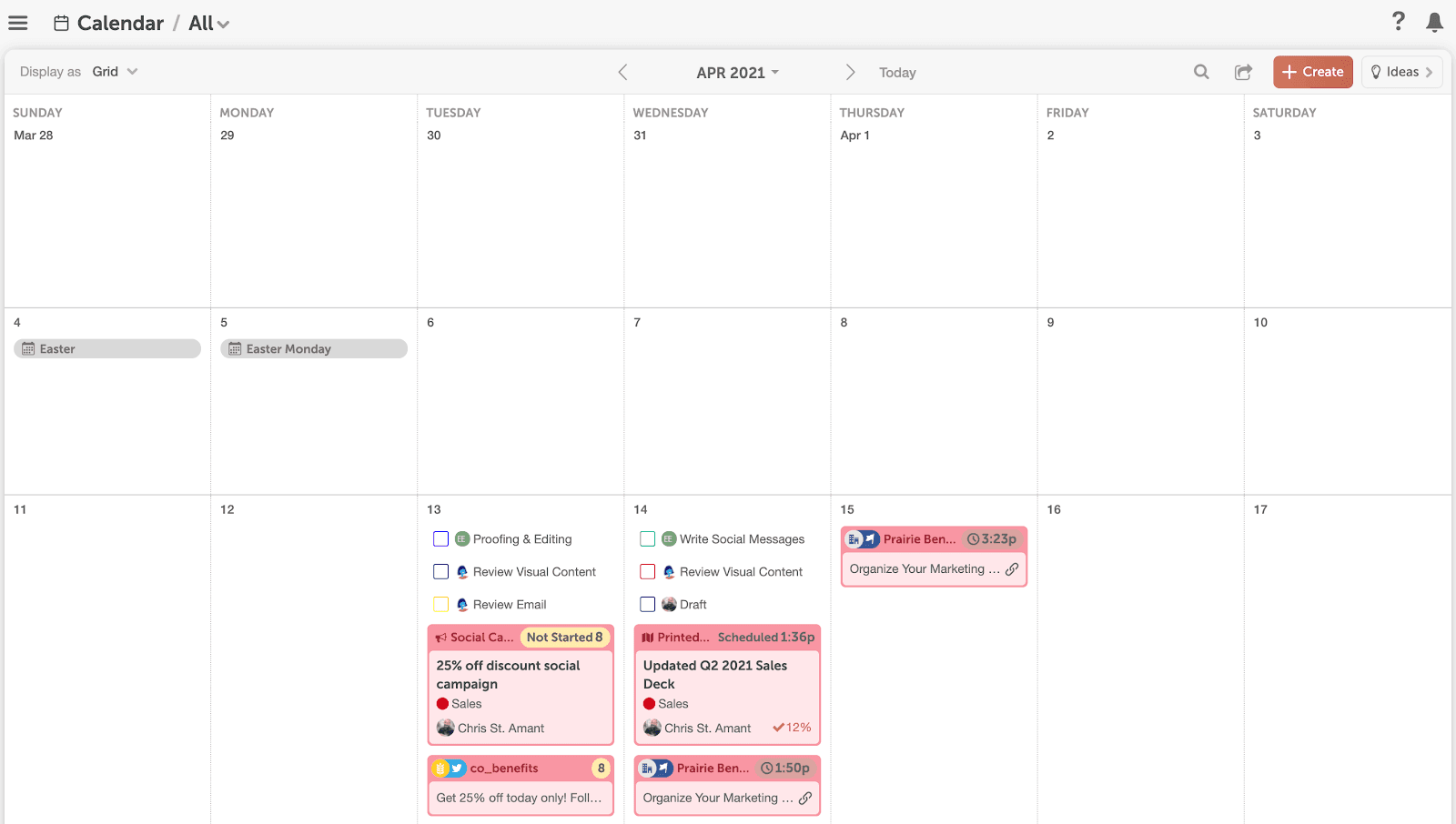
As with spreadsheets overcoming the downsides of printed calendars, CoSchedule makes up for all the limitations of a spreadsheet-based calendar.
Top that with advanced functionality like drag and drop ease, automation, and integrations with other products and you have the best choice.
Here’s what you get with CoSchedule Marketing Calendar:
Provides a central place for all things content.
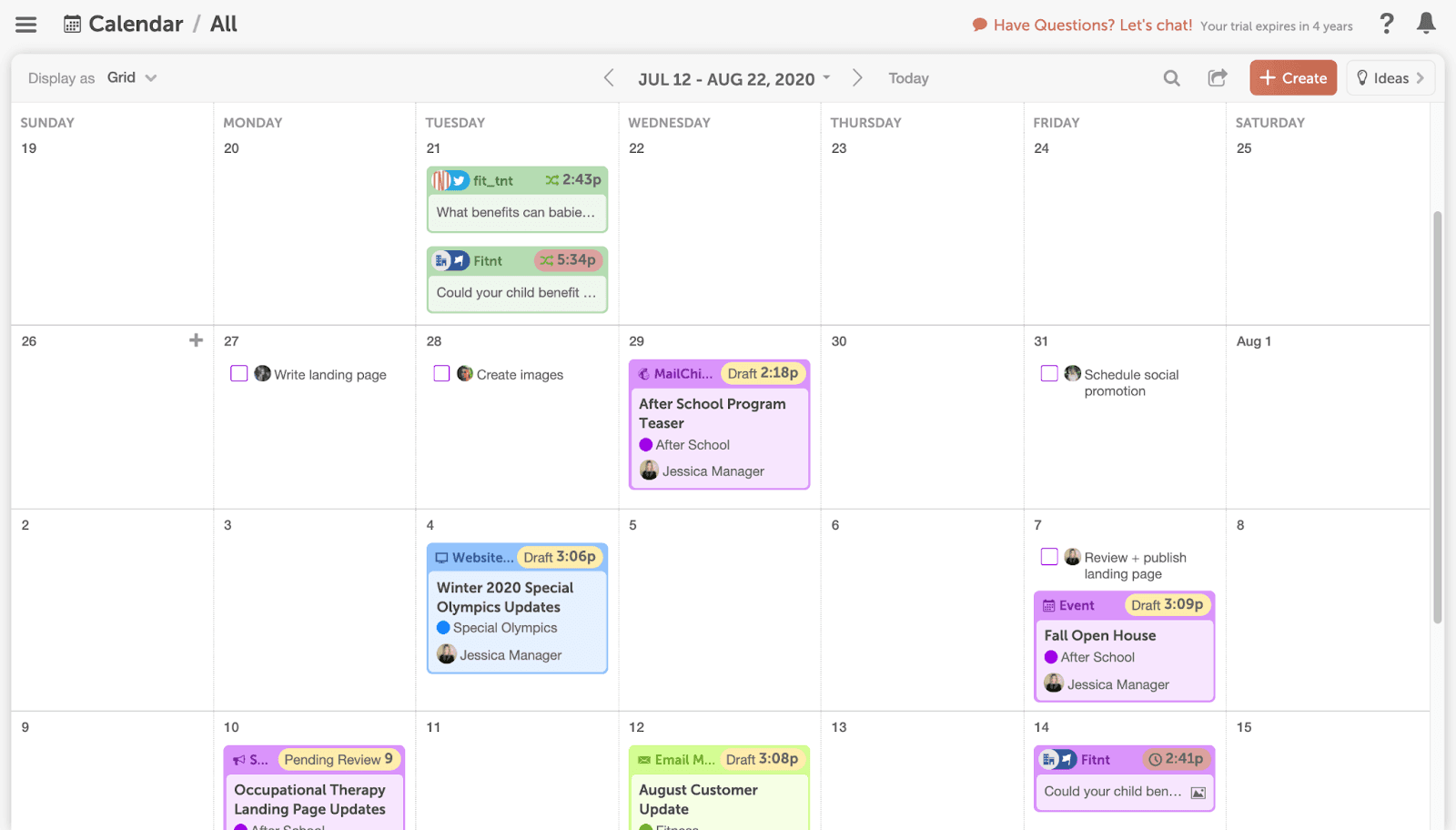
You can manage not just your blog calendar, but social media (which can be toggled on/off) and other content types with CoSchedule. In fact, you can sync the calendar with your Google calendar to view all your meetings in one place.
Offers collaboration in one place

CoSchedule has built-in communication features. This allows you to tag different teammates and share thoughts under the Discussion tab – streamlining communication in one place. No need for a separate communication tool like with spreadsheets.
Drag and drop convenience
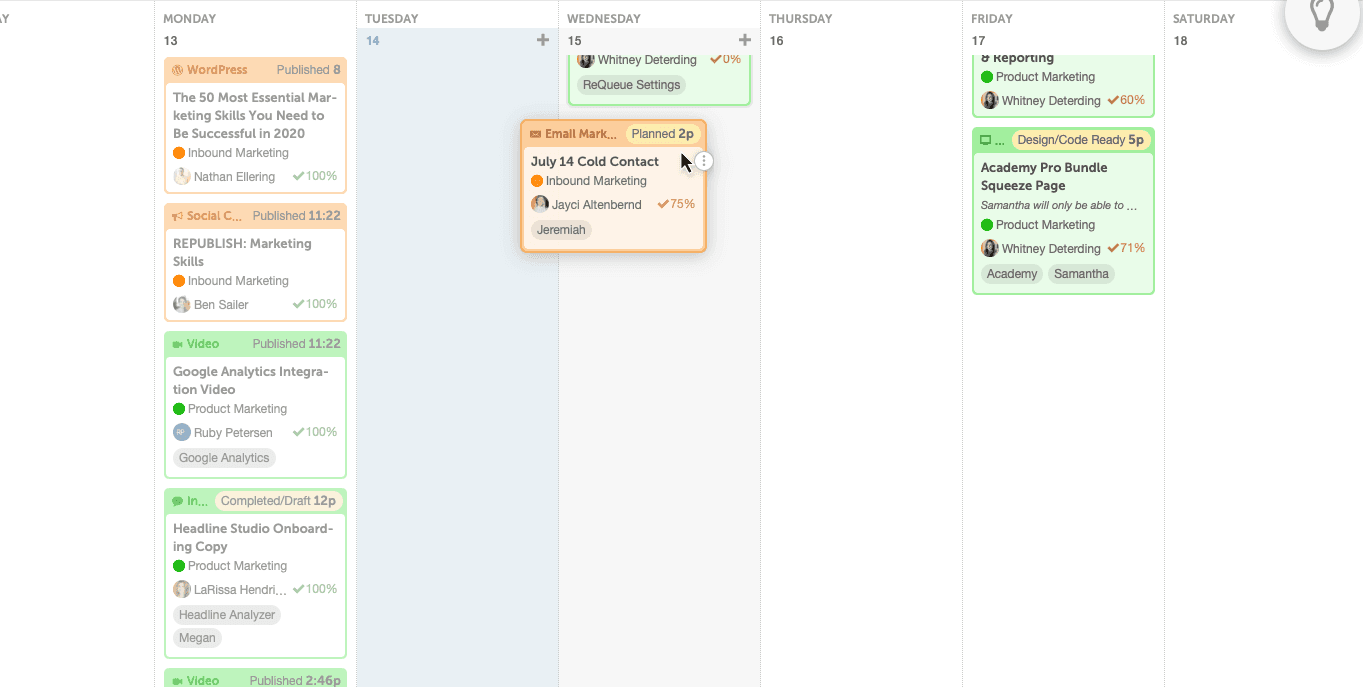
Instead of copy-pasting content into different columns to reflect its status, simply drag and drop content anywhere on the calendar.
Integrates With All Your Other Tools
CoSchedule connects with other tools you’re likely using to help you get more organized and save more time. Integrations include:
- WordPress
- Evernote
- Google Docs / Office 365
- Google Drive / Dropbox / OneDrive
- Social Networks (Facebook, Twitter, LinkedIn, Pinterest, Tumblr, and Instagram)
- Email Service Providers (MailChimp, Active Campaign, Campaign Monitor, and Constant Contact)
And more.
Color-code items

Color-code items on your calendar for easy understanding and quick recognition.
Let’s Look at an Example of an Editorial Calendar
Now to give you an insider look at an editorial calendar example, here’s CoSchedule’s interactive calendar with a numbered list of its key elements:
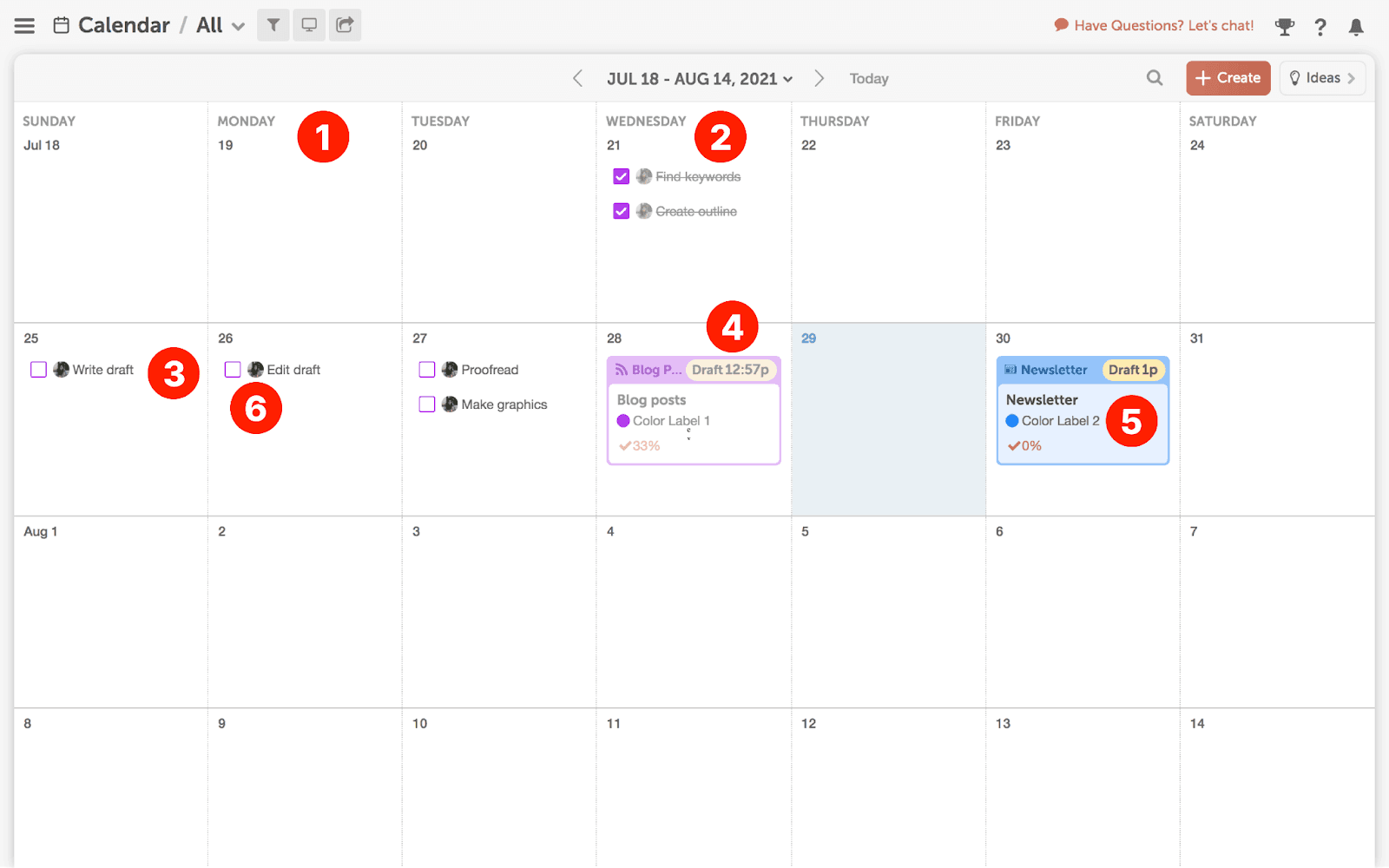
Each number on the screengrab gives you the following:
- Days/weeks: All content plans are laid out in a blocks-based calendar interface.
- Content: Each task under a parent content piece shows up with a checklist icon on the calendar. When the job is done, check off the icon and the task will show as complete.
- Deadlines: Each task reflects on the calendar based on the deadline you select for it (custom date or automatic options: same day as publishing date, a day before publishing, or 3 days before publishing).
- Publish times: Whatever time you select for a task shows up as a time stamp on the day it’s due.
- Color-coding: Different content types are distinguished using different colors. In this case, it’s purple for blog content and blue for newsletter content.
- Assignees: This denotes who on the team is responsible for a given task on the calendar.
Now, Let’s Set Up Your Editorial Calendar Step by Step
Getting to the meat of the matter, let’s talk about how to actually use an editorial calendar in five simple steps below:
Step 1: Gather Your Team
Creating winning content takes time and work. There are a lot of moving pieces involved so you need to fill in several roles.
But let me get this straight: you don’t necessarily need separate team members for each role, particularly if your resources are limited or if you are a one-person team.
You just need someone to fill in the roles and if you’re short of members, one person can wear multiple hats.
For the latter, begin by listing all the work involved in creating a piece of content. If you have folks to help you though, start by filling these roles:
- Writers: Folks who take keywords, product features, and other raw material and use them to draft finished copy.
- Graphic designers: Those who create branded visual assets such as blog headers, social media posters, even GIFs explaining processes in how-to pieces.
- Editors: They review and proofread writers’ drafts for accuracy.
- Project managers: People who handle the high-level stuff – the stories you want to tell, dig into your audience’s interests, and coordinate everything from content ideation to briefing and final sign-offs on each content piece.
- Analysts: Analysts collect performance data on published content to determine how well it’s achieving goals set for it.

I’ll say this again: you don’t need people with specific job titles to do all these tasks. Depending on your team structure and size, different team members can fulfill these roles.
Step 2: Establish Your Publishing Workflow
Having clearly defined steps in your process or a workflow makes publishing by a set schedule achievable. It also makes team collaboration efficient as it spells out everyone’s responsibilities by specific turnaround times.
So how do you create a well-oiled workflow? Follow these steps:
- Figure out each step involved in creating each piece of content.
- Identify who will be best for doing those tasks.
- Decide project handoff points between team members.
- Determine the time by which to complete each task (and in what order).
- Assign and coordinate on tasks with team members.
To prevent anything from slipping through the cracks, it’s best to work with a checklist. Make one listing all the steps involved in creating a single piece of content.
For instance:
- Come up with topic ideas.
- Set a deadline.
- Conduct keyword research.
- Create a brief/outline.
- Write content.
- Edit content.
- Handoff for graphic design.
- Ensure it’s SEO-optimized.
- Proofread content.
- Write social copy for promotion.
- Write email copy for promotion.
- Schedule publishing date and time.
Then, identify who will do each of these tasks and add it to your list. So, for example:
- Come up with topic ideas (team/strategist).
- Set a deadline (project manager).
- Conduct keyword research (SEO specialist).
- Create a brief/outline (project manager).
- Write content (Content writer).
- Edit content (editor/project manager).
- Handoff for graphic design (graphic designer).
- Ensure it’s SEO-optimized (SEO-specialist).
- Proofread content (editor).
- Write social copy for promotion (copywriter).
- Write email copy for promotion (copywriter).
- Schedule publishing date and time (project manager).
Next, estimate how long it will take to complete each step and add it to your list.
- Come up with topic ideas (team/strategist – 30 minutes).
- Set a deadline (project manager – 5 minutes).
- Conduct keyword research (SEO specialist – 2 hours).
- Create a brief/outline (project manager – 2 hours).
- Write content (Content writer – 8 hours).
- Edit content (editor/project manager – 1 hour).
- Handoff for graphic design (graphic designer – 4 hours).
- Ensure it’s SEO-optimized (SEO-specialist – 30 minutes).
- Proofread content (editor – 30 minutes).
- Write social copy for promotion (copywriter – 1 hour).
- Write email copy for promotion (copywriter – 1 hour).
- Schedule publishing date and time (project manager – 5 minutes).
Finally, add the due dates for each content piece and tasks under it in your calendar. But before you do so, add two weeks to each task. That’s how far out in advance your content should be placed on your calendar.
It’s also a good idea to share this checklist with your team to ensure no step is missed.
If you use CoSchedule, you can easily create such a list with Task Templates. These are reusable checklist templates that are automatically added to each content piece on the calendar.
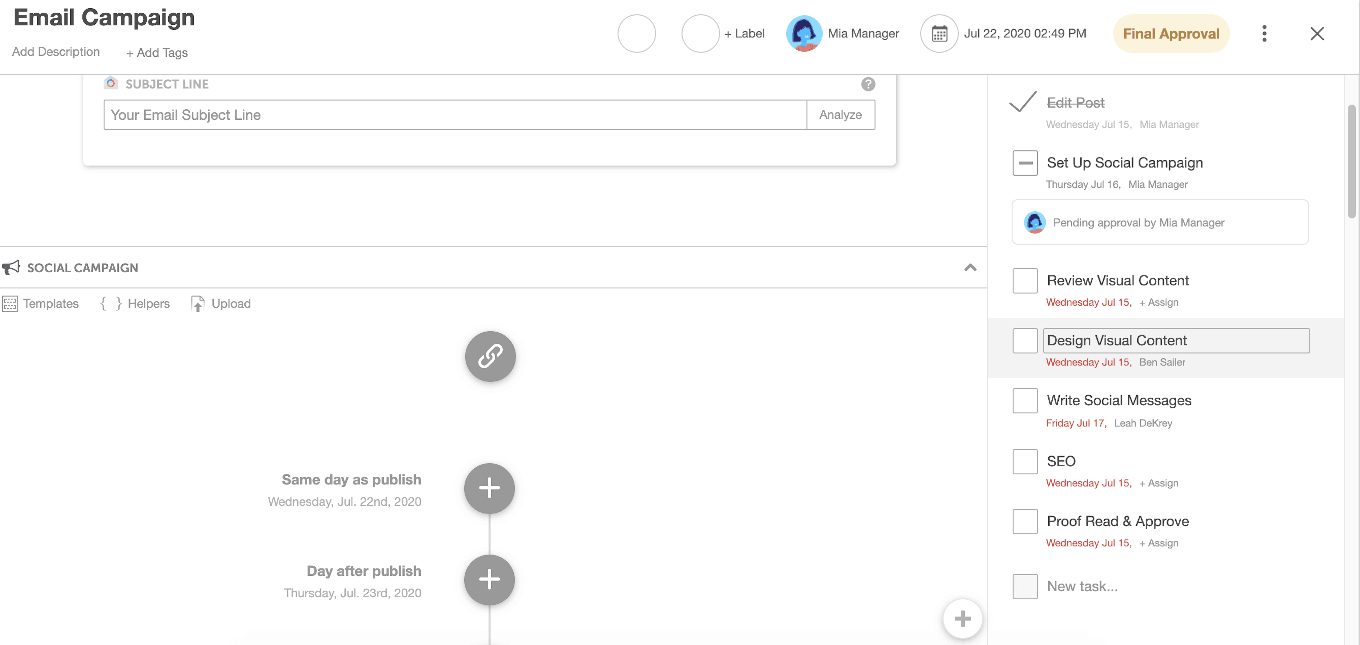
Marking steps as complete in the list will show it to all team members. Plus, completed items will reflect as a percentage on the calendar.

All in all, you’ll have a clearly defined workflow with each job to do alongside their turnaround times. This makes the editorial calendar both an effective place to plan and coordinate content and a tool to help stick with the publishing schedule.
Step 3: Establish Your Publishing Cadence
As much as you’d like, you wouldn’t be able to publish all your ideas as actionable content. This is particularly true if your team has dedicated limited resources to content marketing.
So instead of aiming to run a marathon with your publishing schedule, go ahead and take it slow – one race or content piece at a time.
Start with asking yourself what’s a realistic schedule you can follow? It could be anything from one blog post per week to three every fortnight.
Decide how many:
- Blog posts you’ll publish weekly
- Social media posts you’ll create, and
- Large content pieces (think: ebooks, white papers) you’d push per month/quarter/year
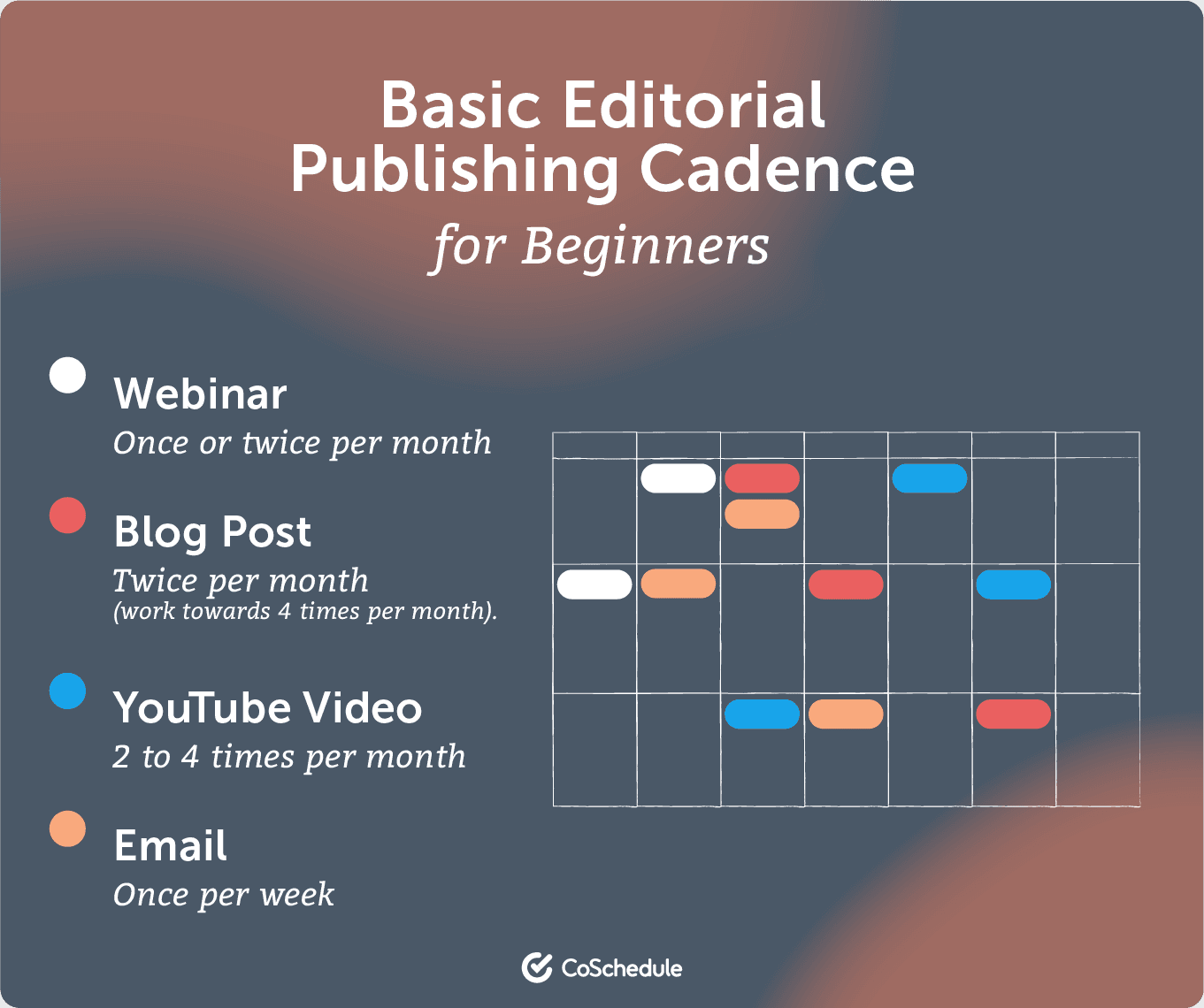
This beginner editorial publishing cadence is a great place to start, and you can easily scale as you get the hang of your process.
Remember: churning out content isn’t enough. You’ll need to reserve time for promoting it too. This means you should also be penciling in time for writing social media captions, creating promotion graphics, and so on.
It’s why I recommend you add every step in your content operation to the calendar to make sure you don’t miss anything.
Step 4: Generate Topic Ideas
Now that you’re clear on how much you have to publish, work on what to publish.
Remember: not every idea is going to align with your marketing objectives and audience interests. It’s why I recommend you identify your content core before jumping into generating ideas.
Know Your Content Core
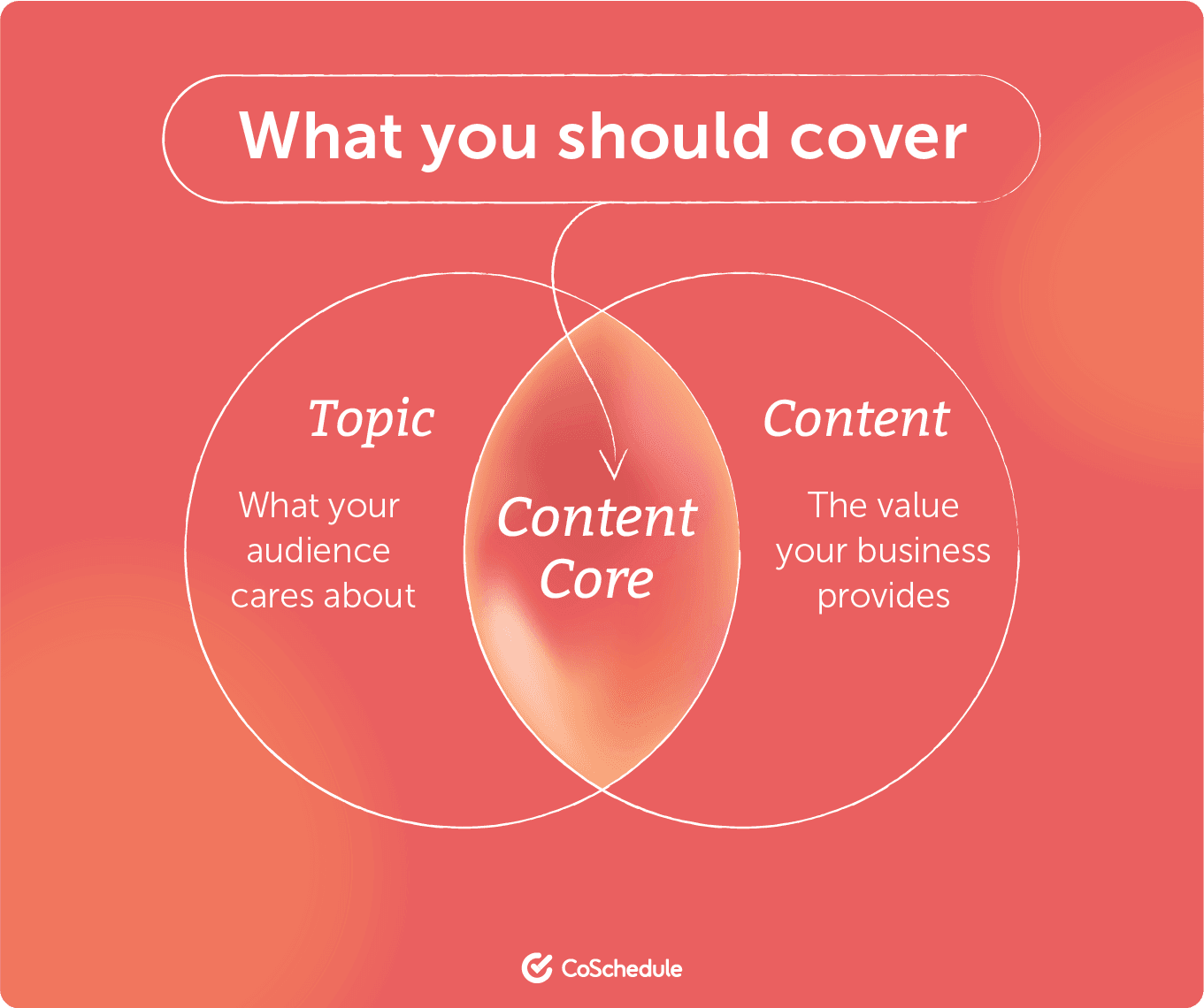
Good ideas are ones that:
- Interest your audience by answering their questions
- Deliver business results by allowing you to pitch your product/service to your audience
A content core is exactly where these two characteristics intersect, helping you cover balanced content ideas relevant to your marketing strategy and audience.
Once you’ve identified the content core, go ahead and drive ideas around it. How? I’ll break that for you in the next three steps using the 30-min content marketing brainstorming process we use at CoSchedule. Read on.
Brainstorm Ideas in 10 Minutes
Kick off the ideation session by writing down every idea that comes to mind on a post-it note in a solo or team, 10-minute brainstorming episode.
Don’t forget to ask customer-facing teams like the sales team to join the session or submit their ideas.
These folks spend a lot of their time talking to prospects and customers. They know their struggles, pain points, and the questions they’re asking. So you can bet they have some good ideas to share.
Score Your Ideas to Find the Best Topics
Of course, not every idea is going to make it to the finalists. It’s why you need to spend the next ten minutes scoring ideas.
Put all idea post-it notes on a board. Then, read them out loud to your team one at a time; asking them to score each on a 3-point scale. Here, 3 means ‘awesome,’ 2 stands for ‘okay,’ and 1 denotes ‘poor.’
This will divide all ideas into three buckets – giving you a bank of good ones that you can work with.
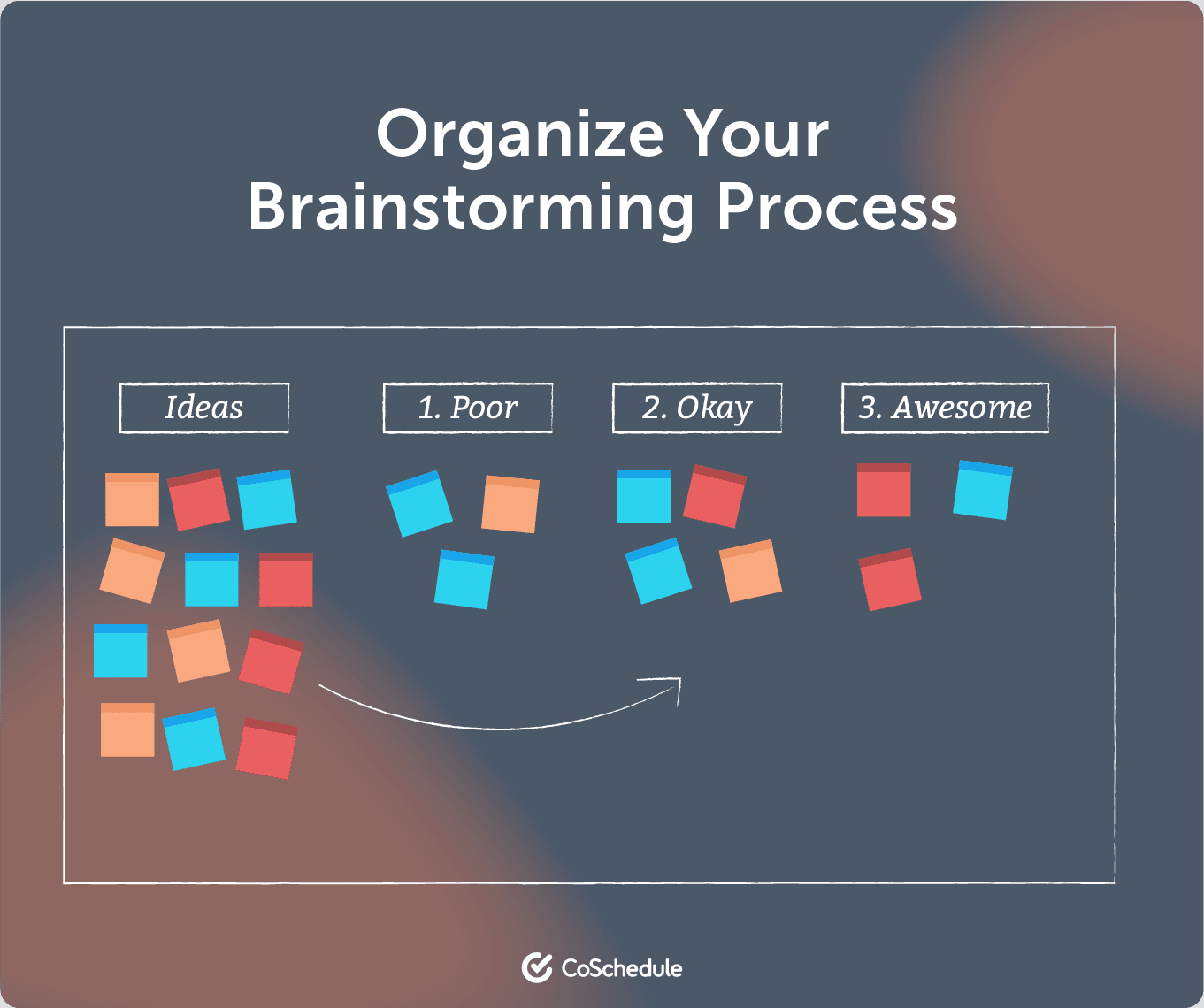
Prioritize Ideas for Publication
In the remaining ten minutes, select from the topics that got the best rating (all the ones rated 3).
From there, choose the ones that are the most relevant to your content core and need to be covered first.
If you’re a one-person team, weigh ideas objectively based on which ones are the most relevant to your company and its audience.
You can also dive into keyword research to approve ideas based on keywords that have the most ranking potential.
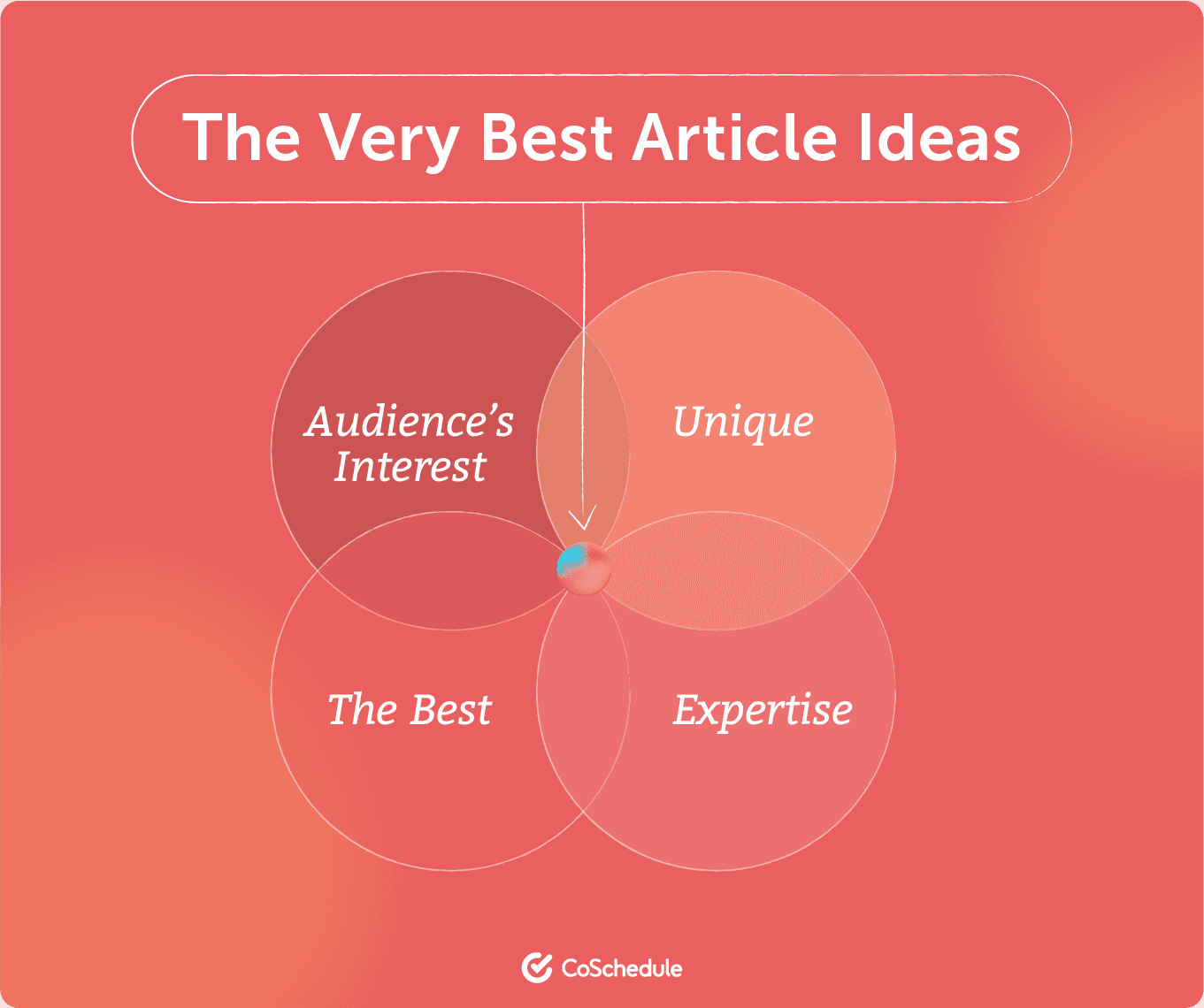
Step 5: Add Your Best Ideas to Your Calendar
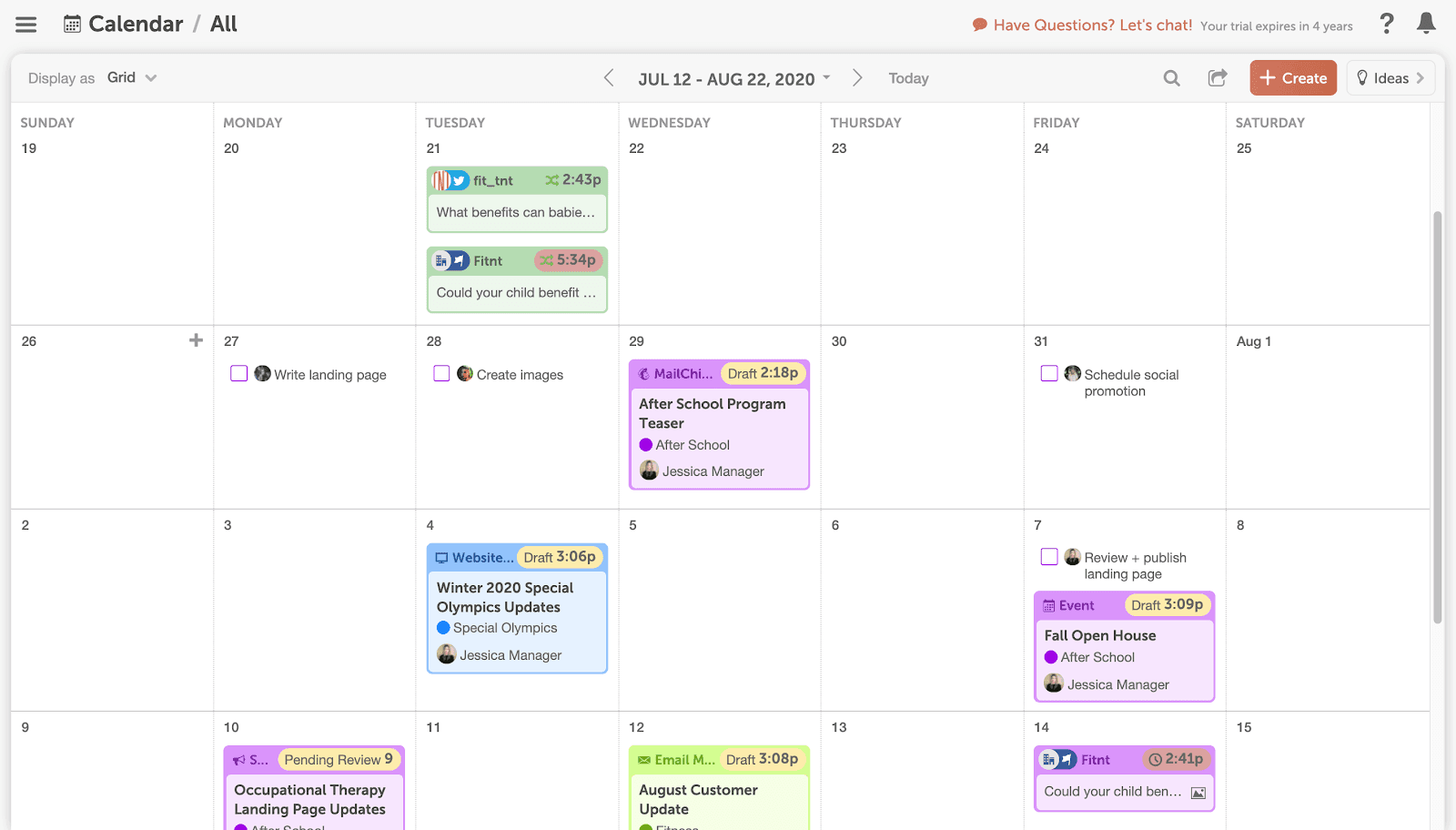
Finally, add these winners to your editorial calendar alongside their due dates.
Your calendar must show deadlines for each step involved in the process of creating each piece. Plus, a final end date by which the piece should be ready.
Having all the content topics, steps involved and the deadlines for each piece in your editorial calendar helps you be:
- More Organized
- More Productive
- More Successful
As for the remaining ideas that scored well, add them to your content backlog. This way, you can pull them out whenever you host your next brainstorming session. Or, use them when stuck in an ideation rut.
The Numbers Don’t Lie: Proof That Editorial Calendars Work
Convinced you need an editorial calendar but not sure how to dispel stakeholder’s doubts?
I’ve got success numbers from a CoSchedule customer that you can share with your boss.
Using our editorial calendar software, the marketing team at ON24:
- Quadrupled blog output from 24 to 112 posts per year. And are now on track to double output/production to 250 blog pieces per year.
- Saw a 98% increase in their blog traffic and a 1,412% increase in organic blog traffic – all this in two short years.
- Schedule 100+ social posts per week, therefore, never missing an opportunity to promote their content.
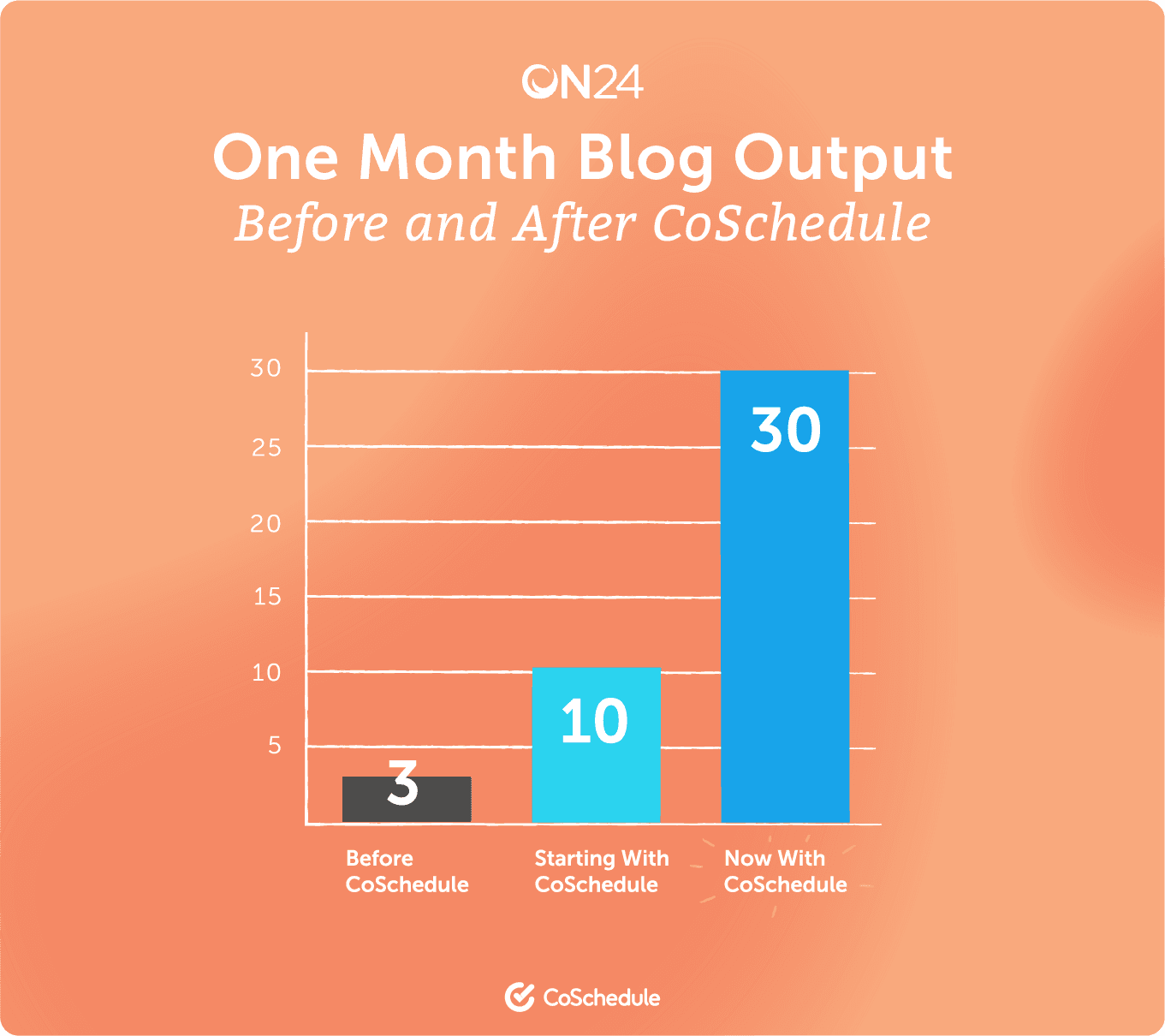
Before using the CoSchedule editorial calendar though, the ON24 marketing team hit hurdle after hurdle as they didn’t have one tool to manage their content production.
Their process wasn’t streamlined and tracking teammates’ tasks was a challenge. What’s more, they frequently missed opportunities and content gaps.
With CoSchedule though, they solved these problems and then some. The calendar software became their centralized hub for managing not just blog content but also social posts.
Using our content calendar, they were also able to visualize their pipeline, which made it easy for them to identify and fill in content gaps.
It also helped them plan campaigns weeks ahead of time, hit deadlines, and reach an amazing publishing frequency.
It’s no wonder their Digital Content Manager Michael Mayday, remarked:
“CoSchedule has given me sanity. Being able to see where there are online content gaps and rearrange content on the fly is absolutely invaluable.”
Common Questions About Editorial Calendars
Finally, before we wrap this up, let’s answer any remaining questions that you may have.
Q: Who uses editorial calendars?
Marketers, bloggers, journalists, content creators, or just anyone who wants to publish quality content regularly.
Q: What are the advantages of using apps vs. spreadsheets?
Apps offer automation features, which take work off your plate. This paired with seamless team coordination makes managing your editorial calendar efficient so you can drive better results. Spreadsheets don’t offer these perks.
Q: So one more time… what can I put on an editorial calendar?
Any content that you want to create. It could be videos, social content, newsletter copy, or any other content type – not just the typical blog posts and articles.
Start Using an Editorial Calendar Now
Once you start planning and organizing content on your calendar, you’ll never go back. Get your team to coordinate with you over it and you’ll see how publishing becomes a well-oiled process that drives real results for your business.
The post How to Plan an Editorial Calendar the Best Way (Template) appeared first on CoSchedule Blog.

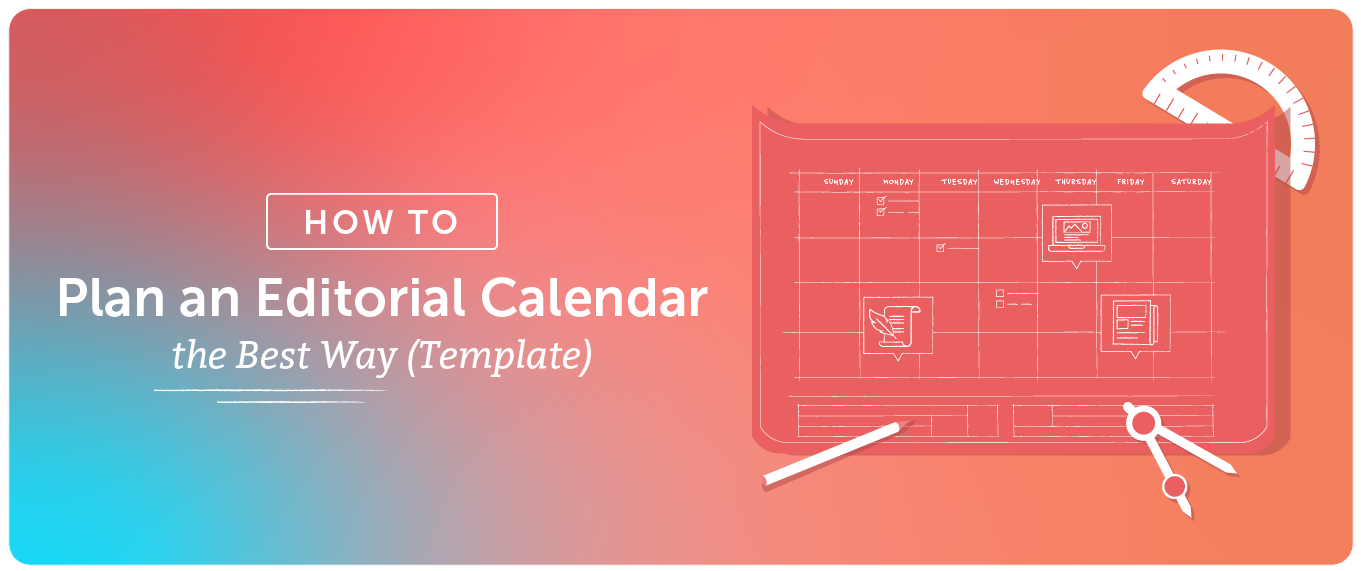

![Read more about the article How to Write White Papers Customers Want [Templates + Examples]](https://www.dimaservices.agency/wp-content/uploads/2022/03/how-to-write-white-papers-header-300x126.png)
